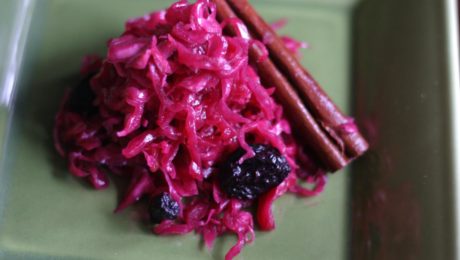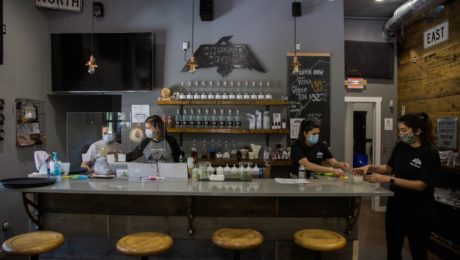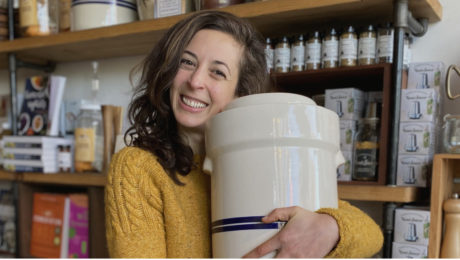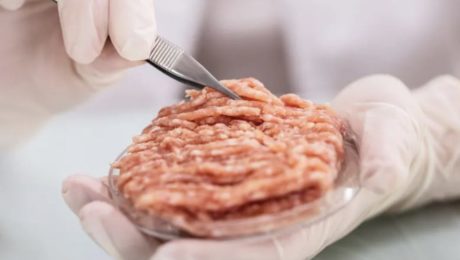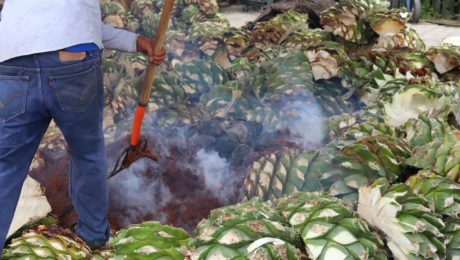“Bacterial Bully” Could Create Healthier & Tastier Fermented Foods
Microbiologists have long considered that there are two distinct categories of energy conservation in microorganisms: fermentation and respiration. Lactic acid bacteria (LAB) use fermentation, making it central to food and drink production and preservation since the dawn of man.
But researchers at the University of California, Davis, and Rice University discovered a LAB species that uses a hybrid metabolism, combining both fermentation and respiration.
“These are two very different things, to the extent that we classify bacteria as basically one or the other,” said Caroline Ajo-Franklin, a bioscientist at Rice University and co-author of the study. “There are examples of bacteria that can do both, but that’s like saying I can ride a bicycle or I can drive a car. You never do both at the same time.”
“What we discovered is a LAB that blends the two, like an organism that’s not warm- or cold-blooded but has features of both,” she said. “That’s the big surprise, because we didn’t know it was possible for an organism to blend these two distinct metabolisms.”
The species — lactiplantibacillus plantarum — is what scientists call a bacterial bully because it takes advantage of two distinct metabolic processes, according to a press release from Rice on the study. These systems were “not previously known to coexist to acquire the fuel they burn for energy.”
“Using this blended metabolism, lactic acid bacteria like L. plantarum grow better and do a faster job acidifying its environment,” said Maria Marco, a professor in the food science and technology department at UC Davis and the study’s co-author [and a TFA Science Advisor].
The discovery is significant for food and chemical production. New technologies that use LAB could now produce healthier and tastier ferments, minimize food waste and change the flavors and textures of fermented food.
“We may also find that this blended metabolism has benefits in other habitats, such as the digestive tract,” Marco said. “The ability to manipulate it could improve gut health.”
The study began with a puzzle: the realization that genes responsible for the electron transfer pathway in mainly respiratory organisms also appear in the LAB genome. “It was like finding the metabolic genes for a snake in a whale,” Ajo-Franklin said. “It didn’t make a lot of sense, and we thought, ‘We’ve got to figure this out.’”
While the Davis lab studied the genome, the team at Rice carried out fermentation experiments on kale.
“It wasn’t our first choice,” said Rice alumna and co-lead author Sara Tejedor-Sanz (now a senior scientific engineer in the Advanced Biofuels and Bioproducts Process Development Unit at Lawrence Berkeley National Lab).
“We performed some initial experiments with cabbage, since that’s a known fermented food — sauerkraut and kimchi — in which lactic acid bacteria are present,” she said. “But there were technical difficulties and it didn’t turn out so well. So we looked for another food to ferment where LAB could be found in its ecological niches.
“Kale has compounds like vitamins and quinones that lactic acid bacteria use as cofactors in their metabolism, and are also involved in interacting with the electrodes,” she said. “We also found fermenting kale to make juice was a trend. It sounded perfect for our biochemical reactors.”
The study showed LAB enhances metabolism through a FLavin-based Extracellular Electron Transfer (FLEET) pathway that expresses two genes (ndh-2 and pp1A) associated with iron reduction, a step in the process of stripping and incorporating electrons into ATP (adenosine triphosphate (ATP), energy-carrying molecule).
Because LAB’s genome has evolved to be small, thus requiring less energy to maintain, the wide conservation of FLEET must serve a purpose, Ajo-Franklin said.
“Our hypothesis is this helps bacteria get established in new environments,” she said. “It’s a way to kick-start their metabolisms and outcompete their neighbors by changing the environment to be more acidic. It’s being a bully.”
That the FLEET pathway can be triggered with electrodes offers many possibilities, she said. “We found we can use the hybrid metabolism in food fermentation,” Ajo-Franklin said. “Now we have a way to change how food may taste and avoid failed food fermentations by using electronics.”
“We may also find that this blended metabolism has benefits in other habitats, such as the digestive tract,” Marco said. “The ability to manipulate it could improve gut health.”
Ajo-Franklin noted LAB are commonly found in the microbiomes of many organisms, including humans. “You can already buy it in health food stores as a probiotic,” she said. “The human gut is an anaerobic environment, so LAB have to keep a redox balance. If it oxidizes carbon to gain energy, it has to figure out a way to reduce carbon somewhere else.
“Now we think if we provide another electron donor or acceptor, we could promote the growth of positive bacteria over negative bacteria.”
UC Davis graduate student Eric Stevens is co-lead author of the study. Co-authors are Rice graduate student Siliang Li; at UC Davis, graduate students Peter Finnegan and James Nelson, and Andre Knoesen, a professor of electrical and computer engineering, at UC Davis; and Samuel Light, the Neubauer Family Assistant Professor of Microbiology at the University of Chicago.
Ajo-Franklin is a professor of biosciences and a CPRIT Scholar. Marco is a professor of food science and technology.
The National Science Foundation, Office of Naval Research, the Department of Energy Office of Basic Energy Sciences and a Rodgers University fellowship supported the research.
The study results were published in the journal eLife.
- Published in Food & Flavor, Health, Science
Whey-Based Spirits
Wisconsin-based Native American distillery Copper Crow is using whey to make vodka and gin. Whey (the liquid byproduct of cheesemaking) gives the liquors a creamy, sweet, sake-like taste.Copper Crow one of only a handful of distilleries in the world that makes whey-based spirits.
Whey can be difficult to dispose of. Every pound of cheese leaves behind nine pounds of whey, but it cannot be poured down a drain or into farm fields because it consumes oxygen. Many cheesemakers use it for animal feed or fertilizer.
“The market for the protein-rich, lactose-clouded liquid is minuscule — mostly makers of workout snacks and wellness tonics — but distillers represent a small yet emerging new customer base, with American producers beginning to follow the lead of those in the U.K., France, Australia, and New Zealand,” reads an article on Copper Crow in Fortune.
Copper Crow sits on the Red Cliff Reservation, with Lake Superior artesian aquifers providing pristine water. Owners Curtis and Linda Basina are members of the Red Cliff Band of the Lake Superior Chippewa. Prohibition laws from 1834, though, barred Native Americans from trading alcohol on their reservations.So it would be illegal to run a distillery on their reservation.
The Bassinas found a loophole to the racially-motivated ban — they own title to the land where the distillery is located. Their application was approved, “a watershed moment for Native American entrepreneurs long denied a slice of a booming craft-distilling industry.”
Read more (Fortune)
- Published in Business, Food & Flavor
San Francisco’s Growing Chocolate Scene
In San Francisco, a “booming Bay Area confection ring” is developing.. Julia Street, a former food tech industry exec, is the latest entrant. She is now a self-taught chocolatier running J Street Chocolate.
Street began pursuing chocolate “to follow her obsession with all things fermented.” The experimental chocolates “only a scientist could dream up” are made using upcycled ingredients from other fermenters in the city. For example, she uses spent grains from Laughing Monk Brewing in her Piv Snack Bars. She tells Eater that the ethics behind the chocolate are important to her, too. Her 68% cacao bar is sourced from the Dominican Republic, and sales support a Northern Dominican agroforestry project.
Other Bay Area chocolate shops that have cropped up in recent years include Dandelion Chocolate, Topogato and Kokak Chocolates.
Read more (Eater)
- Published in Business, Food & Flavor
2022 Alt Meat Trends & Challenges
“The landscape of cell-cultured meat, and even microbially fermented animal products, is a complicated place where futuristic technology, ethics, the law and business are all approaching the unknown together,” reads a Forbes article.
There are at least 60 companies globally now involved with cell- and fermentation-grown meat, and nearly a billion dollars was invested in the field in 2021 alone.
Animal-free meat, though, is facing growing pains. Forbes shares the trends and challenges in the rapidly-growing alternative protein industry. Some of their predictions and observations:
- Accelerator and incubator programs will help new companies start.
- Startups lead the pack, influencing larger companies to invest in their own animal-free lines.
- Truly animal-free options, as companies develop proprietary methods that don’t require animal input.
- Knowledge sharing, the trend that more companies will not gatekeep their intellectual property.
- Production of all “meats,” rather than just beef and chicken. (Companies are developing animal-free foie gras, fish maw and even zebra.)
- Alt breast milk, using stem cells.
- Cheaper products, as the higher prices of alternative proteins keep some consumers away.
- Regulatory challenges, as regulatory agencies debate terminology and labeling requirements.
Read more (Forbes)
- Published in Business
Food and Beverage Laws Passed in 2021
After the Covid-19 pandemic shortened their legislative sessions last year, lawmakers across the 50 states had a productive year in 2021. State leaders were able to pass hundreds of bills relating to food, beverages and food service.
Numerous new laws were aimed at helping restaurants survive — permitting permanent outdoor dining spaces, allowing carryout food services and to-go alcohol sales. Many of these regulations had been enacted in 2020 as temporary, emergency measures to aid restaurateurs, but expired this year.
This year was also big for cottage food laws. As more people experimented in their home kitchens during the pandemic, there was pressure to modernize cottage food laws. Over half the states updated their laws in 2021, regulating sales of homemade food.
Below are the key food, beverage and food service laws passed this year in, alphabetically, Alabama through Maryland. We’ll feature the balance of the states — Massachusetts to Wyoming — in TFA’s next newsletter (January 12, 2022).
Alabama
HB12 — Extends protections granted for cottage food businesses to include roasted coffees and gluten-free baking mixes.
HB539 — Increases the amount of alcohol which breweries and distilleries can sell to customers for off-premise consumption.
SB126 — Allows licensed state businesses to deliver wine, beer and spirits to customers’ homes.
SB160 — An update to Alabama’s cottage food law, SB160 allows for most non-perishable foods to be made in home-based food businesses without commercial licenses (instead of just only baked goods, jams/jellies, dried herbs and candies). It also removes the $20,000 sales limit for home-based food businesses. It also allows online sales and in-state shipping of products.
SB167 — Permits Alabama wineries to sell directly to consumers at special events.
SB294 — Authorizes wine manufacturers to sell directly to retailers without a distributor.
SB397 — Allows opening of wineries in Alabama’s 24 dry counties. The wineries will be allowed to produce and operate in a dry county, but they may not sell on premise.
Alaska
HB22 — Legalizes herd share agreements for the distribution of raw milk in the state.
Arizona
HB2305 — Amends law to allow two or more liquor producers, craft distillers or microbrewery licenses at one location.
HB2753 — States that licensed producers, craft distillers, brewers and farm wineries are subject to rules and exemptions prescribed by the FDA. Exempts production and storage spaces from state regulation.
HB2773 — Allows bars, liquor stores and restaurants to sell cocktails to-go.
HB2884 — Exempts alcohol produced on premise in liquor-licensed businesses from food safety regulation by the Arizona Department of Health Services, which adds rules regarding production, processing, labeling, storing, handling, serving, transportation and inspection. Specifies that this exemption includes microbreweries, farm wineries and/or craft distilleries.
Arkansas
HB118 — Permits the sale of cottage foods over the internet. Interstate sales are permitted if the producer complies with federal food safety regulations.
HB1228 — Allows for municipalities in dry counties to apply to be an entertainment district, just like in wet counties.
HB1370 — Establishes mead as an allowed liquor for a small farm winery — and allows wineries to ship mead. Also allows for mead to be taxed in the same manner as wine.
HB1426 — Establishes the Arkansas Fair Food Delivery Act, stating that a food delivery platform (like UberEats) must have an agreement with a restaurant or facility to take food orders and deliver food prepared.
HB1763 — Allows distilleries to self distribute their own products and allows out-of-state, direct-to-consumer shipments.
HB1845 — Restricts advertising alcohol in microbrewery-restaurants in dry counties.
SB248 — Replaces Arkansas’ cottage food law with the Food Freedom Act. Allows all types of non-perishable foods to be sold almost anywhere without a food safety license and certification, including grocery stores and retail shops.
SB339 — Allows permitted restaurants to sell on-the-go alcoholic beverages.
SB479 — Allows restaurants with alcohol beverage permits to expand outdoor dining without approval of the Alcoholic Beverage Control Division.
SB554 — Authorizes beer wholesalers to distribute certain ready-to-drink products.
SB631 — Authorizes a hard cider manufacturer to deliver hard cider.
California
AB61 — Allows restaurants and bars with alcohol licenses that added temporary, outdoor sidewalk dining spaces during the Covid-19 pandemic to continue serving alcohol in these spaces.
AB239 — Allows wineries to refill wine bottles at off-site tasting rooms, similar to breweries reusing growlers
AB286 — Requires third-party delivery companies to itemize cost breakdowns of delivery transactions to both restaurants and customers.
AB425 — Updates regulations regarding definitions, assessments, fees and funding mechanisms for the Dairy Council of California.
AB831 — Mandates that all labels on cottage food must include the disclaimer “Made in a Home Kitchen” along with the producer’s county and cottage food permit number.
AB941 — Establishes a grant program for counties to apply for farmworker resource centers, supplying farmworkers and their families information on education, housing, payroll, wage rights and health services.
AB962 — Requires the creation of a returnable bottle system in the state by 2024. Allows recyclable bottles to be washed and refilled by beverage producers rather than being crushed for recycling.
AB1144 — Updates California’s outdated cottage food laws, raising sales limit to either $75,000 (Class A permits) or $150,000 (Class B permits) and simplifying the approval process for sampling cottage food products. Also allows homemade food to be sold online.
AB1200 — By 2023, no eatery in California is permitted to distribute or sell food packaging that contains regulated perfluoroalkyl and polyfluoroalkyl substances or PFAS. Manufacturers of food packing must use the least toxic alternative when replacing their food packaging. Food packaging includes food or beverage containers, take-out containers, liners, wrappes, eating utensils, straws, disposable plates, bowls and trays.
AB1267 — Allows licensed manufacturers, distributors and sellers of alcoholic beverages to donate a portion of beverage purchases to a nonprofit.
AB1276 — Requires California eateries to only give take-out customers single-use utensils and condiment packets if they ask for them.
AR15 — Establishes Nov. 22 as Kimchi Day in the state.
SB19 — Allows wineries to open additional off-site tasting rooms without applying for a new license (former law allowed for only one off-site tasting room).
SB314 — Allows restaurants and bars that added temporary, outdoor sidewalk dining spaces during the Covid-19 pandemic a one-year grace period to apply for permanent expansion.
SB389 — Allows restaurants and bars to serve to-go alcohol alongside a meal.
SB453 — Establishes an Agricultural Biosecurity Fund specifically for the California State University system’s Agricultural Research Institute. The California State University’s 23 campuses and 8 off-campus branches can then use that fund to apply for grants related to supporting research on agriculture biosecurity, best practices around infectious agents hurting the state’s animal herds and plant crops.
SB517 — Authorizes a licensed beer manufacturer who obtains a beer direct shipper permit to sell and ship beer directly to a resident of the state for personal use.
SB535 — Makes it unlawful to manufacture or sell imitation olive oil in the state. Also restricts using “California Olive Oil” on a label unless 100% of the oil is derived from olives grown in California. The label can also only share that the oil comes from a specific region of California if at least 85% of the olives were grown in that region.
SB721 — Establishes Aug. 24 as California Farmworker Day.
Colorado
HB1027 — Extends sales of to-go alcohol from licensed restaurants and bars to 2026.
HB1162 — The Plastic Pollution Reduction Act, the law bans single-use plastic bags and containers made from polystyrene (styrofoam) for restaurants and other retailers by 2024. All stores will also implement a 10-cent bag fee for plastic and paper bags by 2023.
SB35 — Prohibits third-party restaurant delivery services from cutting pay to a driver to comply with fee limits. Also prohibits third-party delivery services from putting restaurants on their platforms without the eateries’ permission.
SB235 — Sends the Department of Agriculture $5 million for energy efficiency and soil health programs.
SB270 — Allows more Colorado wineries, cideries and distillers to attain a pub license and sell a variety of food in addition to their craft beverage. Current law puts small limits on the amount of craft drink made for a brewery to sell food, leaving out larger Colorado producers.
Connecticut
HB5311 — Enables permitted transporter to sell and serve alcohol on boats, motor vehicles and limousines.
HB6610 — Codifies expanded outdoor dining, allowing municipalities to close off streets and sidewalks for outdoor restaurant dining space.
SB894 — Allows patrons to pour their own alcoholic drinks at restaurants and bars. Will allow self-pour automated systems to be used in the state’s dining establishments.
HB6580 — Expands food agricultural literacy programs of study and community outreach, by increasing certification, education and extension programs with rural suburban and urban farms for students in grades Kindergarten through 12th grade.
Delaware
HB1 — Allows restaurants to continue selling to-go alcohol beverages. The bill also allows restaurants and bars to continue using outdoor dining spaces originally used during the Covid-19 pandemic.
HB46 — Allows brewery-pub and microbrewery license holders to brew, bottle and sell hard seltzers and other fermented beverages made from malt substitutes. Also includes a specific tax on fermented beverages.
HB143 — Reduces the amount of licensed taprooms to only one taproom within a ½ mile from another taproom.
HB212 — Increases minimum thickness for plastic bags (used by grocery stores and restaurants) to qualify as a reusable bag from 2.25 mils to 10 mils.
SB46 — Allows wedding venues and event centers licensed as bottle clubs to allow customers to bring alcoholic beverages on premise.
Florida
HB751 — Authorizes issuance of special licenses to mobile food vehicles to sell alcohol beverages within certain areas.
HB1647 — Allows more Orlando eateries to sell alcohol. Allows eateries with a smaller footprint (80-person capacity; formerly 150-person capacity) to sell beer, wine and spirits in six additional Orlando Main Street Districts.
SB46 — Increases production limits for distilleries from 75,000 gallons a year to 250,000 gallons. Eliminates the “six bottles per person per brand per year” requirement. Also allows craft distilleries to qualify for a vendor’s license to conduct tastings at Florida’s fairs, trade shows, farmers markets, expositions and festivals.
SB148 — Authorizes restaurants or bars also holding a public food service license to sell or deliver alcoholic beverages in sealed, to-go containers.
SB628 — Establishes a new program, the Urban Agriculture Pilot Project, to distinguish between traditional rural farms and emerging urban farms. Exempts farm equipment used in urban agriculture from being stored in certain boundaries.
SB663 — Updates Florida’s cottage food law to allow shipping of products, and raises the sales limit for shipped cottage food from $50,000 to $250,000. The bill also prevents counties or cities from banning cottage food businesses (Ed. note: Florida’s largest county, Miami-Dade, prohibits cottage food businesses).
SR2041 — Establishes a Food Waste Prevention Week in the state to acknowledge the importance of conserving food and preventing food waste.
Georgia
HB273 — Allows local municipalities to pass an ordinance, resolution or referendum election to authorize allowing a liquor store to open in their jurisdiction
HB392 — Allows a person to have a mixed cocktail or draft beer from the hotel delivered to their room by a hotel employee.
HB498 — Expands eligibility requirements for the state’s tax exemption for agricultural equipment and farm products. Any family-owned farm entity (defined as two or more unrelated, family-owned farms) can now share equipment, land and labor without losing ad valorem tax exemptions enjoyed by stand-alone family farms.
HB676 — Creates a legislative advisory committee on farmers’ markets (Farmers’ Markets Legislative Advisory Committee), made up of five members from the state’s Senate and House.
SR155 — Recognized February 17 as State Restaurant Day.
SB219 — Permits small brewers to sell alcohol for consumption on their premise. Allows state’s breweries to transfer beer between locations.
SB236 — Extends the Covid-era rule that allows restaurants to sell to-go alcohol.
Hawaii
HB817 — Requires state agencies to purchase an increasing amount of locally grown food.
HB237 — Earmarks $350,000 to the department of agriculture for the mitigation and control of the two-lined spittlebug, which has damaged nearly 2,000-acres of pasture land.
SB263 — Establishes a “Hawaii Made” program and trademark, to promote Hawaiian-made products.
Idaho
HB51 — Amends existing law to provide nutrient management standards on dairy farms. Allows dairy farmers the option of using phosphorus nutrients.
HB232 — Changes the distribution of tax on high-alcohol-content beer from the state wine commission to the state hop growers commission, helping promote the craft industry.
Illinois
HB2620 — Allows small breweries, meaderies and winemakers to distribute their products to local bars, grocery stores and liquor stores directly rather than through a third party.
HB3490 — Amends Illinois Food, Drug and Cosmetic Act, which says, if a restaurant includes milk as a default beverage in a kid’s meal, the drink must be dairy milk and contain no more than 130 calories per container or serving.
HB3495 — The Brewers Economic Equity & Relief Act, allows for limited brewpub self-distribution, permanent delivery for small alcohol producers, direct-to-consumer shipping for in-state and out-of-state brewers and distillers and self-distribution for manufacturers producing more than one type of alcohol.
HR33 — Creates the Illinois Good Food Purchasing Policy Task Force to study the current procurement of food within the state and explore how Good Food Purchasing can be implemented to maximize the procurement of healthy foods that are sustainably, locally and equitably sourced.
HR46 — Urges the Illinois Department of Agriculture to study the effects and the types of land loss to Black farmers. Calls for state support and capacity building for Black farming communities across the state and a dedication to helping grow agriculture in rural, urban, and suburban areas.
HR117 — Urges the United States Department of Agriculture and the United States Department of Commerce to increase the exportation of Illinois dairy products to other nations.
SB2007 — The Home-to-Market Act, updates the state’s Illinois Cottage Food Law. Expands sales avenues for cottage food producers, allowing sales at fairs, festivals, home sales, pick-up, delivery and shipping (cottage food was previously only allowed to be sold at farmers markets).
Indiana
HB1396 — Updates many of Indiana’s outdated alcohol laws, some from the Prohibition Era. Amended various sections of Indiana’s alcohol code impacting permittees, trade regulation and other various definitions.
HB2773 — Allows bars, liquor stores and restaurants to permanently sell to-go alcohol orders, originally allowed temporarily during the Covid-19 pandemic.
SB144 — Allows bulk wine purchasing limits for farm wineries to apply only to wine sold directly to a consumer and not to wine sold through a wholesaler. Also allows the holder of an artisan distiller permit to also hold a distiller’s permit.
SB185 — Creates a working group made up of industry organizations, food safety experts, Indiana State Department of Health, Indiana State Board of Animal Health and Indiana State Department of Agriculture to submit recommendations to the state concerning home-based vendors and cottage food laws.
Iowa
HB384 — Updates rules regarding alcohol licenses. Lengthens the hours of sale for alcoholic beverages on Sunday.
HF766 — Allows home delivery of alcoholic beverages from bars and restaurants by third-party delivery services, such as Uber or DoorDash.
Kansas
HB2137 — Allows bars, liquor stores and restaurants to permanently sell to-go alcohol orders, originally allowed temporarily during the Covid-19 pandemic.
Kentucky
HR3 — Recognizes March 23 as Agricultural Day in the state.
HR19 — Recognizes June as Dairy Month, honoring the state’s dairy workers.
SB15 — Allows a microbrewery licensee to sell and deliver up to 2,500 barrels of product to any retail licensee and to set forth terms of contracts between microbrewers and distributors.
SB67 — Allows bars, liquor stores and restaurants to permanently sell to-go alcohol orders, originally allowed temporarily during the Covid-19 pandemic.
Louisiana
HB192 — Authorizes credit card payment to manufacturers and wholesale dealers of alcoholic beverages (when previously cash was only allowed).
HB219 — Allows the delivery of ready-to-drink alcohol beverages (sold in manufacturer sealed containers), allowing brewers with a brewing facility to self-distribute.
HB269 — Allows authorized state employees to destroy meat, seafood, poultry, vegetables, fruit or other perishable food of foreign origin which are subject of a current import ban from the federal government.
HB291 — Allows self-distribution to any brewer who operates a brewing facility in the state.
HB706 — Adds microwinery to microdistillery permits.
HR104 — Designates May 19, 2021, as Louisiana Craft Brewers’ Day in the state.
HR210 — Authorizes a state subcommittee to study and make recommendations to the government on the regulation of the growing craft brewing industry in the state.
Maine
SB133 — Clarifies that licensed Maine manufacturers of spirits, wine, malt liquor and low-alcohol spirits products may sell and ship their products to a person located in another state.
SB205 — Allows bars and restaurants to permanently sell to-go alcohol orders through take-out and delivery services if the liquor is accompanied by a food order. Also temporarily permits licensed Maine distilleries that operate tasting rooms but do not operate licensed on-premise retail to sell spirits through take-out and delivery services accompanied by a food order.
SB306 — Temporarily waives certain requirements for relicensing for restaurants that serve liquor to help food establishments during the Covid-19 pandemic.
SB307 — Allows all Maine alcohol manufacturers to sell directly to out-of-state consumers (current law only allows wine to be sold out-of-state).
SB479 — Amends definition of “low-alcohol spirits product” by raising the maximum alcohol level of a low-alcohol spirits product from 8% to 15%.
SB630 — Prohibits shelf-stable products from being sold as cider. Products that do not require refrigeration or are heat-treated cannot be labeled as cider.
SB636 — Establishes the Local Foods Fund, which helps schools purchase produce and other minimally processed foods from local farmers and producers.
SB822 — An act affirming that food seeds are a necessity in the state.
Maryland
HB185 — Prohibits an alcoholic beverages license holder from requiring that an individual buy more than one bottle, container or other serving of alcohol at a time.
HB264 — Requires entities that generate at least two tons of organic waste per week to arrange for disposal alternatives, like reduction, donation, animal feed or composting.
HB269 — Establishes the Urban Agriculture Grant Program in the Department of Agriculture to increase the viability of urban farming and improve access to urban-grown foods.
HB 555 — Repeals a prohibition on allowing drugstores to apply for a liquor license.
HB1232 — Codifies emergency orders to grant permanent to-go delivery of alcohol and online shipment privileges.
SB205 — Authorizes local alcoholic beverage licensing boards to temporarily allow restaurants and bars to sell to-go alcoholic beverages. Also requires Maryland’s Alcohol and Tobacco Commission and the Maryland Department of Health to study expanding alcohol access.
SB821 — Codifies the governor’s 2020 executive order to grant alcohol delivery and shipment. Also allows permitting to serve alcohol at off-premise, special events.
Fermenting Coffee with Koji?
A two-time Finnish Barista Champion made headlines with his unique cup of joe at the World Barista Championship in Italy — a koji-fermented coffee.
Aiming to make better coffee than what’s available on the market, Kaapo Paavolainen (pictured) studied how he could maximize the flavor in coffee beans. “Sugar in beans is responsible for coffee’s inherent sweetness but the lack of it results in unpleasant bitterness. But the current methods can extract only 70% of available sugar,” he told Forbes.
After reading about koji in the books Koji Alchemy (by Jeremy Umansky and Rich Shih) and The Noma Guide to Fermentation (by Rene Redzepi and David Zilber), he realized koji can tap into the remaining 30% of sugar in beans.
Incredibly, this koji-based method was used on subpar coffee beans in experiments and still transformed the coffee. Umansky described the flavor as “deep, earthy and leathery. Depending on the roasting level of the beans, the flavor ranged widely from tropical fruits like pineapple and mango to chocolate and gingerbread. The mouthfeel was strikingly silky and luxurious like butter. The rounded, full-bodied texture made these tastes last very long.”
Paavolainen aims to scale the koji process with a partner farm in Columbia. This new coffee method could aid coffee farmers, many of whom are financially challenged and are struggling to maintain farms in the face of climate change.
Read more (Forbes)
- Published in Business, Food & Flavor
The Brewing Coffee-Farming Crisis
Many pressures are building on coffee farmers, making their jobs increasingly difficult. Climate change is causing numerous impacts — temperatures are rising, rainfall is increasingly unpredictable, weather can swing from drought to flood, and new crop pests are emerging. And these problems are on top of existing environmental concerns, as growing coffee requires large amounts of water.
Further, studies show that, even with “modest declines of greenhouse gas emissions, about 50 percent of the land with conditions suitable for growing the two main species of coffee, arabica and robusta, which account for 99 percent of commercial supply, ‘could disappear by 2050.’ Brazil and Vietnam, major producing countries, would be especially hard hit.”
The Times details several organizations’ efforts to aid coffee farmers by restoring and protecting water resources, supporting more efficient use of water, improving crop yields with targeted fertilization and starting a global breeding network for new coffee species that can withstand tough climates.
Read more (The New York Times)
Analyzing Mexico’s Traditional Fermented Beverages
A research team has made the first comprehensive analysis of Mexico’s traditional ferments. Utilizing the country’s native cacti, agaves and maize, these diverse beverages are unique to their region. But they are poorly studied, and some are endangered as they fall out of style with younger generations.
“Many of Mexico’s finest microbiologists and ethnobotanists are giving ever-greater attention to this fascinating but once-forgotten foodscape, but even they are willing to admit that we’re just beginning to scratch below the surface of understanding all the biodiversity in these bottles of blessed ferment,” says Gary Paul Nabhan, research scientist at the Southwest Center of the University of Arizona (U of A).
Researchers in various disciplines (microbiology, ethnoecology and genetics) from five different schools (U of A and four universities in Mexico) took part in the study. The results, Traditional Fermented Beverages of Mexico: A Biocultural Unseen Foodscape, are published in the international journal Foods.
Sixteen traditional Mexican fermented beverages were identified: tepache, pulque, hobo, Mexican wines, colonche, nawait, pozol, sidra, tejuino, tesgüino, taberna, cocoyol, tuba, Mexican palm wine, balché and xtabentún. Those 16 drinks were made from 143 plant species and include 102 genre of microorganisms.
In each region, “a distinctive set of plant roots, leaves, fruits and stems were added as fermentation catalysts, flavorants, colorants and stabilizers,” reads the U of A press release. “A large number of bacterial strains and yeasts — in addition to common brewer’s yeasts and water kefir grains — enabled the nutritional transformation of these raw materials into a wide array of unique nutritionally rich, probiotic beverages.” The team mapped the regional variations and ecological niches of the fermented drinks.
Sustainable Future
The study notes this level of analysis is “indispensable” to promote fair trade and sustainable food production. Industrial mezcal, for example, has created a monoculture of blue agave, and farm labor often works in exploitative conditions.
“These products have been embedded as part of the daily lives of many people, including those currently marginalized rural or Indigenous groups,” the study reads. “The diversity of fermented products is an outstanding reservoir of genetic resources that has high potential to obtain secondary products such as extracts, enzymes, dyes, and others compound that can be involved in global markets and could help to solve problems such as hunger and poverty and may play a key role to reinforce cultural identity..”
Traditional Mexican fermented beverages also provide important nutrients for consumers as the globe battles a changing climate.“The naturally-occurring yeasts and kefir-like tibico grains found in association with prickly pear cacti, saguaro fruit, century plants and desert spoons (sotols) likely tolerate much higher ambient temperatures than those from the semi-arid highlands and wet tropical forests,” Nabhan explains.
Extinct Drinks
Some healthier artisanal drinks “have fallen out of fashion and face local or broad extinction,” the press release notes. In some areas of the country, these “forgotten ferments” are still used in the home, but not commercialized.
“Now that the days of Prohibition are over and there is a great need for arid-adapted crops with highly-efficient water use, some of these traditional agave and cactus varieties should be revived for the local production of healthful beverages,” Nabhan suggests. “In fact, traditional beverages such as tepache, tesguino and colonche have made a comeback in the Tucson, Arizona, region since it received recognition as a UNESCO City of Gastronomy. These traditional beverages are also being employed by mixologists in novel cocktails now being featured in nearly every state of Mexico.
- Published in Food & Flavor, Science
Chocolate Without the Cacao
Cacao is one of the most environmentally harmful and ethically dubious commodities produced on the planet. It plays a huge role in deforestation, uses an alarming amount of water and more than 2 million children work in cacao farms. Yet cacao hasn’t been reimagined the way other foods with similarly harmful footprints have.
“There’s a lot of ethical quandaries around the production of chocolate,” says Johnny Drain, PhD, co-founder of WNWN Food Labs. “Cacao is a huge contributor to climate change, and child labor and slave labor are hardwired into the supply chain.”
Drain’s nickname is the “Walter White of fermentation” because of his work helping pioneering restaurants and bars around the world incorporate fermentation into their food and drink. Now Drain can add “Willy Wonka of chocolate” to his resume. He is co-launching a cacao-free chocolate, next in the wave of alternative products designed to replicate flavor and texture without a harmful production cycle.
A Chocolate-Potato Connection?
WNWN (Waste Not, Want Not, pronounced “Win-Win”) happened by chance. About five years ago, Drain was boiling old, green potatoes, and leaned his head into the steam. He was surprised it smelled like chocolate.
“I had this light bulb moment where I thought ‘There must be some compounds within the skins that are also found in cacao and chocolate.’ I wondered — ‘Could I make chocolate from potatoes? What other weird and wonderful things could make chocolate?’” Drain says.
WNWN plans to release a small-run batch of their chocolate next month. Drain and co-founder Ahrum Pak, a former investment banker and fellow fermenter-turned-food-activist, are calling the product category choc.
WNWN’s choc ingredients are proprietary until its formal release but, as with traditional chocolate, they are plant-based and fermented. Drain describes them as familiar, whole ingredients that are common in an average person’s diet.
“It’s not a Frankenstein, lab-created product, mixing this potion with that potion. We take whole ingredients, we ferment them just as we would chocolate, then we end up with this delicious chocolatey paste that goes into a quite conventional chocolate-making procedure,” Drain adds.
WNWN also replaces cocoa butter — made from cacao pods — with plant-based oils. Cocoa butter is what gives traditional chocolate a silky, creamy texture as it melts in your mouth.
Fermented Flavors
At the heart of choc’s flavor, though, is fermentation.
“Cacao is fermented to make chocolate in the same way our product is fermented. We use similar, friendly microbes to create complexity,” he says. “We’re recreating that flavour profile of chocolate that we all know and love using the same fundamental techniques that are used to make chocolate.”
High-quality chocolate contains roughly 600 different flavor and aroma molecules. Cacao fermentation involves lactic acid and acetic acid bacteria, along with various yeasts, to create its flavor.
“If you didn’t have that cocktail of microbes, you would end up with something that only tastes vaguely like the chocolate we know and love,” he adds. “At the heart of this is fermentation. The product that we have, if we produced it without the fermentation processes, it wouldn’t taste anything like chocolate, just like if you eat a raw cocoa bean or even a roasted, unfermented cocoa bean, it doesn’t really taste like chocolate. You have to have that very complex cascade of chemical reactions, made possible by the fermentation, to get the final chocolate flavour.”
The Next Big Alt Movement?
Drain is quick to point out WNWN is not the only company trying to create what he and Pak have coined “alt-chocolate.” Three companies — QOA, Voyage Foods and Cali-Cultured — all officially launched in the past three months.
Some of these companies have been operating in stealth mode for a number of years but made official launches once word of competitors began to circulate. QOA and Voyage appear to be using approaches similar to that of WNWN. CaliCultured is using a syn-bio precision fermentation route to modify yeast cells to produce lab-grown cacao cells that are genetically identical to those found in the wild.
Drain says he’s encouraged by the other companies.
“It’s exciting that there’s multiple people working in this space,” he says. “Look at the plant milk space or alternative protein space — there’s definitely plenty of room in this marketplace too, and collectively we are all doing this because we care about the ethical and environmental damage being wrought by the current cacao supply chain.”
European and American consumers historically dominate chocolate sales, but chocolate sales all over the world are increasing.
Drain and Pak feel that a shake-up in the industry at the top is needed. Huge international producers are responsible for the vast majority of global chocolate. Mars, Nestle and Hershey promised over 20 years ago to stop using child laborers, but reports say the problem continues.Similarly, these companies pledged a decade ago to source more sustainable chocolate, but negative environmental problems from cacao continue to increase.
“The way in which we consume food has to change. It’s unrealistic that millions of tons of mass-produced cacao is somehow ethically- and sustainably-produced,” Pak says.
Drain adds; “So, really, we’re not anti-chocolate, we’re anti-big-chocolate produced in unethical, unsustainable ways.”
Recreating Food
Chocolate is merely the first challenge that WNWN wants to address. Coffee and vanilla are next, foods with similar human rights and sustainability concerns. The company is building a software system that can ideate fermentation pathways for creating sustainable, flavour-identical analogs to delicious – but unsustainable – products.
“When you really start looking at how most of the world’s food is produced and consumed, there are so so many cases where it’s produced in a really terrible and damaging way,” Drain says. But “the market wouldn’t have been ready for a product like this five years ago. People are becoming much more aware of where their food comes from. People are thinking about ‘How do I make my purchasing habits, my diet better for the planet in a way that I don’t have to sacrifice the flavors and taste that I love?’ There will be work to do. But people are more receptive now that fermentation is more of a household name than it was five years ago. I think the fact that more people want to remedy these challenges is brillant.”
Drain will be speaking FERMENTATION 2021 on “The Alt-Universe”
- Published in Business, Food & Flavor

